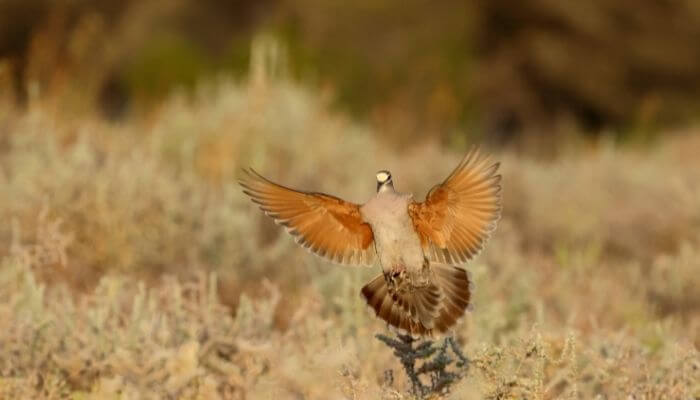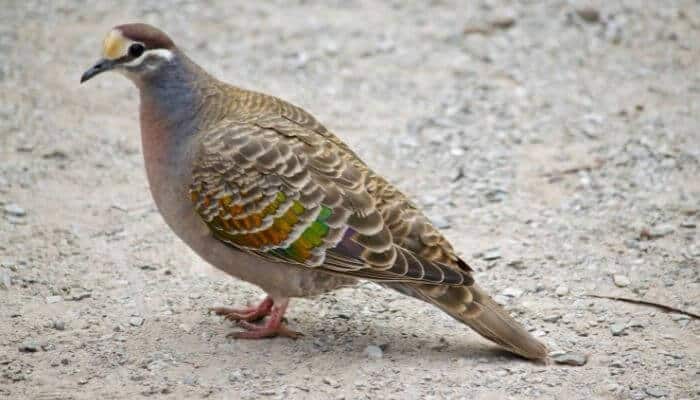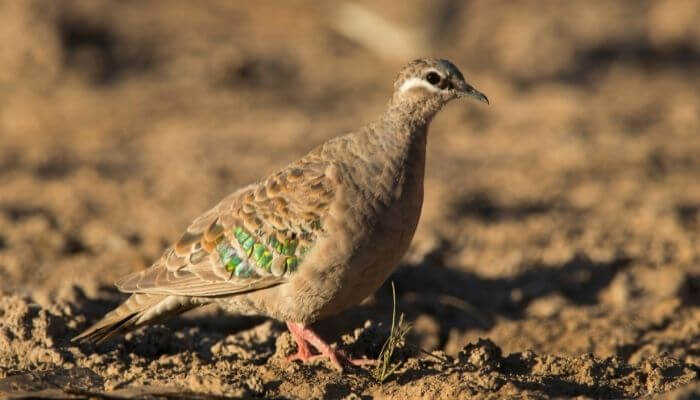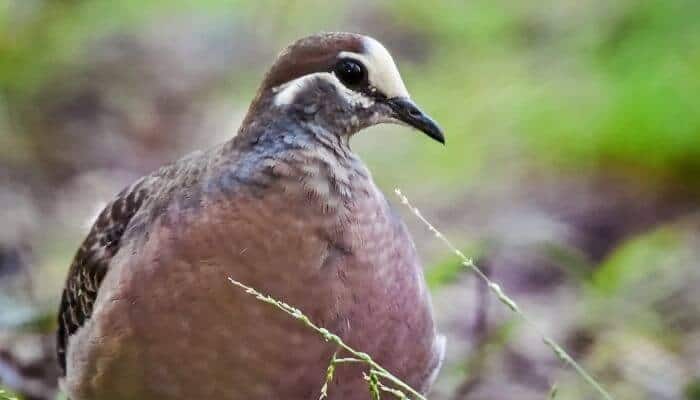The common bronzewing is a medium-sized, heavily built pigeon. It is a sturdy bird adaptable to most environments.

This pigeon breed is native to Australia but has some dedicated fanciers and breeders in the UK, USA and Europe.
Origins of the Common Bronzewing
Very numerous, the common bronzewing is a hardy breed of pigeon native to Australia.
It is one of the most common breeds of pigeon that you will find in the country (Australia has 20 native species of pigeon including the Wonga pigeon ).

The breed is widespread and is found across different regions of Australia.
There are numerous sub-species.
These all have the same basic characteristics with most of the differences arising due to choice of and adaption to their habitat.
Subspecies are:
- brush bronzewing
- flock bronzewing
- crested pigeon
- spinifex pigeon
- partridge pigeon
- squatter pigeon
A long-established breed, the common bronzewing has been known since colonial times. In his book “The Voyage to Botany Bay”, an account of the First Fleet expedition, Captain Arthur Phillip pictured and described the bird.
In 1790, the bird was ascribed its name common bronzewing pigeon by John Latham. Although the name was reaffirmed by John Gould in 1843, gradually pigeon was dropped and in 1931, Neville Cayley listed it simply as common bronzewing in his famous work “What Bird Is That?”
The fact remains, however, that the common bronzewing is a pigeon and a striking one at that.
Distribution And Habitat of the Common Bronzewing
One of the most impressive things about the common bronzewing is how it has adapted to many different habitats across Australia.

The only two exceptions to this rule are areas that are extremely barren and areas that are extremely dense rainforests. Something that is a certainty, however, is that common bronzewings are rarely ever found too far away from a source of water.
This breed has such a sense of water that people in the outback would follow the birds to their water source. There is a story that common bronzewings saved the life of explorer Charles Sturt who, when in desperate need of water, followed the birds to their drinking pool.
Distribution is still widespread. The common bronzewing has long fallen out of favor as a caged bird. It is also no longer widely hunted for food allowing populations to thrive – this trend has been general worldwide with a major decrease in the demand for pigeon meat.
On the official conservation status spectrum, the common bronzewing is placed within the ‘Least Concern’ category so this species is abundant and among the least worried about in terms of endangerment or extinction.
Appearance of the Common Bronzewing
| Wingspan | Length | Weight | Coloring | |
|---|---|---|---|---|
| Common Bronzewing Pigeon | 50 – 58 cm | 30 – 36 cm | 230 – 390 g | Males – brown with patches of red, blue and green on the wings Females – greyish with the patches |
| Average Feral Pigeon | 64 – 72 cm | 32 – 37cm | 300 – 500 g | Bluish grey with some black. |
As with many species of pigeon, the appearance of the common bronzewing differs between the sexes.
Male common bronzewings have foreheads that range from pale yellow to yellow-white, accompanied by pink breasts. Both males and females share a noticeable white line around their eyes.

Common bronzewings also have striking patches of green, red and blue on their wings. Young common bronzewing tend to be duller in their coloring, losing their brown patches as they mature.
The coloring provides fairly decent camouflage, enabling the birds to blend in with the ground and particularly, leaf litter.
Generally, common bronzewings are smaller than the feral pigeons that are common across the world. They are shorter, weigh less and have shorter wingspans.
Character of the Common Bronzewing
Common bronzewings tend to be very cautious birds. This means that it is very difficult for both humans and other animals to be successful in approaching them.
This breed is content to live alone, in pairs or in small flocks.

Like all pigeons, common bronzewings love to communicate with each other and rather than a more traditional cooing sound, this bird’s vocalization is a mournful whoop.
Although not such a common practice in modern times, common bronzewings were kept as pets and caged birds, so they have a good temperament.
Diet of a Common Bronzewing
The common bronzewing is a ground feeder and its diet is typical of what a pigeon eats only with a greater proportion of vegetable matter. So that means seeds, grains, grasses, nuts, berries etc.
The species tends to go out in search of food in small groups, and these searches can sometimes last for days on end depending on the kinds of environments and conditions in which it lives.
The one thing that the common bronzewing needs to worry about during times like these is not getting too dehydrated.
Since the common bronzewing needs to drink frequently for obvious health reasons, it makes sure to take advantage of any water holes and other available sources of water along its route.
The Mating and Breeding Process of Common Bronzewings
This pigeon constructs a rough nest that is made primarily from sticks and twigs usually placed low down in a bush or a tree, not too high up for fear of their eggs and/or hatchlings falling from a risky height.
Pigeon eggs hatch roughly 14 to 16 days after laying, with both the male and female undertaking periods of incubating. Both parents also share responsibilities for caring for their young, which isn’t always the case among pigeon species.
Like the majority of pigeon breeds, the common bronzewing produces crop milk to feed their hatchlings. In general, common bronzewings are regarded as being very caring and attentive pigeon parents, more so than many other breeds.
Being a majorly Australian bird, European and American fanciers don’t get many opportunities to own a common bronzewing, but you do see these striking birds occasionally up for sale.
